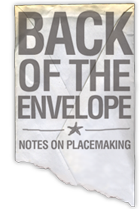 In 2006 I was in Ocean Springs, Mississippi, for a planning event. On display downtown at the time was the prototype Katrina Cottage and a number of us spent one evening there conducting a spontaneous test of its ability to host a party. At some point, I ended up on the porch with a prominent new urban architect and, noting the cottage’s smooth Hardiplank siding, asked him, “Why do you think people always seem to choose the Hardiplank with faux woodgrain when the smooth is so much more natural and attractive looking?”
In 2006 I was in Ocean Springs, Mississippi, for a planning event. On display downtown at the time was the prototype Katrina Cottage and a number of us spent one evening there conducting a spontaneous test of its ability to host a party. At some point, I ended up on the porch with a prominent new urban architect and, noting the cottage’s smooth Hardiplank siding, asked him, “Why do you think people always seem to choose the Hardiplank with faux woodgrain when the smooth is so much more natural and attractive looking?”
His response: “I don’t know. Vulgarity?”
 There is a certain irony to the whole thing. In an effort to appear more wood-like, the false grain — to my eye — actually makes it appear less so. Natural wood emerges from the mill smooth as a baby’s bum so it’s always confounded me as to why, for a lot of people, Hardie’s fabricated woodgrain seems to be the preferred choice.
There is a certain irony to the whole thing. In an effort to appear more wood-like, the false grain — to my eye — actually makes it appear less so. Natural wood emerges from the mill smooth as a baby’s bum so it’s always confounded me as to why, for a lot of people, Hardie’s fabricated woodgrain seems to be the preferred choice.
Is the idea that it makes a house look more weathered, as though it’s been scraped and painted many times over the years? Is it that people won’t accept a new building material unless it goes overboard imitating an accepted one?
I honestly don’t know. But I do know that the smooth version offers superior aesthetics so let’s settle the matter once and for all.
What do you think?
–Scott Doyon
If PlaceShakers is our soapbox, our Facebook page is where we step down, grab a drink and enjoy a little conversation. Looking for a heads-up on the latest community-building news and perspective from around the web? Click through and “Like” us and we’ll keep you in the loop.











Is it possible that at least some of the folks choosing homes with Hardiplank have never seen a home made with real wood and therefore don’t know it’s not supposed to look like that? In my community, homes have been required to be built with 80% masonry for years, and I assume a number of people who grew up in communities like this have no idea what to expect from real wood siding. This wouldn’t explain everyone who installs Hardiplank but might explain some of its use. What do others think?
Interesting take, Lilybet. For me, though, the trend has seemed most obvious in new urban communities where the vernacular style is taken from the surrounding area. So it would seem there’d be some easy comparison opportunities.
I asked why the smooth Hardi wasn’t being used once at a community in Alabama. The response was, “the builders are afraid to try it.” Wasn’t sure what to make of that.
I think it’s the manufacturers’ misguided efforts to overdo the aping of the material they’re trying to be like.
Fiber-cement lap siding with the look of expensive cypress, or cedar which is selected from the better grades of this wood and is deliberately sanded smooth. The dopey wood grain stuff looks like it was left out in the weather over for a couple years. I expect that before long Jame Hardie and their competitors will introduce siding that appears to be even further down the road to decay, with new features like faux splits, actual knotholes, wane, warping and the curled edges. We had to pay a premium for smooth in Northern California until our volume was high enough for regular drop shipments. Everyone else was using the dopey simulated grain and smooth was considered a “special order” arrrgh!
Ouch, My house is guilty of this. Too bad there’s not a big plastic wand dangling from the side of my house that I could twist like miniblinds to reveal the other side. *sigh*
Great commentary. I have always wondered this myself. I think people like it because it makes them think they got “more” for their money (compared to vinyl siding) and no idea how dopey it looks. I have the smooth on my house and it looks great.
Our community has both, but the wood-grain is by far the most common because the builders think it hides installation mistakes better. They could care less about the aesthetic issue you raise— they just care about call-backs and price/availability from the local lumber yard. Regional and national trade reps have confirmed that this is the common reasoning.